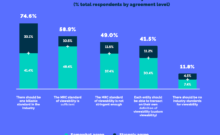With the news that global ad spend growth is predicted to slow in 2018 , it’s clear to see that the impact of transparency concerns are continuing to rise. This trend is being driven, in part, by the efforts of global brands calling for further accountability in digital.
From P&G’s Q2 2017 earnings report – which detailed how slashing millions in ad budgets didn’t impact its bottom line – to Unilever’s stark warning to social platforms that ‘breed division’ in society, it is evident that a focus on media quality and building a trustworthy ecosystem are to be key themes for the year ahead.
While this focus on media quality is undeniably a positive step towards a new phase of transparent and accountable media buying, planning decisions are still yet to be based on the three essential pillars of ad quality: for advertising to be viewable, brand safe and fraud-free.
So what understanding is there of the connection between the three pillars themselves and what they really mean for advertising efficiency? To maximise the value of every impression, marketers need a full picture before they part with their budgets. And to do that they must ensure planning is based on a holistic and unbiased view of inventory that shows the true impact of all factors on ROI.
To make sure advertising reaches the next stage of efficiency, marketers will need to consider the following golden rules of media planning:
Read More at The Original Article: www.thedrum.com









